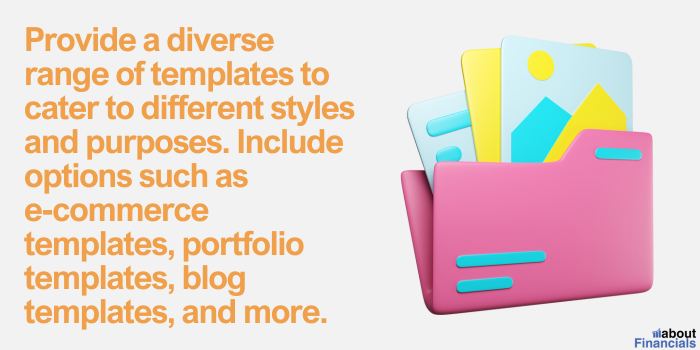In today’s digital age, where having a professional website is essential, the demand for website templates is continuously on the rise.
As a savvy entrepreneur, you can capitalize on this growing market and make money by selling website templates.
By offering high-quality website templates, you can cater to the needs of aspiring website owners who lack the technical skills or budget to create a custom website from scratch.
This presents a lucrative opportunity to generate income while helping others establish their online presence.
In the following sections, we will explore the ins and outs of making money by selling website templates.
Understanding the market for website templates
The demand for website templates has been steadily growing due to the rising number of businesses and individuals seeking an online presence.
Highlight the advantages that website templates offer to potential buyers. These benefits include cost-effectiveness, time savings, ease of use, and the ability to achieve a professional look without extensive design and coding skills.
Identify the industries and niches that can benefit the most from website templates. Consider the specific needs and preferences of businesses within these sectors, such as e-commerce, consulting firms, restaurants, and more. By targeting niche markets, you can create templates that cater to their unique requirements.
Creating high-quality website templates
Stay up-to-date with current design trends to ensure your templates are modern and visually appealing.
Explore popular websites, blogs, and design resources to understand the latest styles, color palettes, typography choices, and layout trends.
Incorporate these elements into your templates to attract customers who seek contemporary designs.
Responsive and Mobile-Friendly
Ensure that your templates are optimized for different screen sizes and devices, providing a seamless browsing experience for users across desktops, tablets, and smartphones.

Design templates with clear and logical navigation menus, allowing visitors to easily explore different sections of the website. Consider the hierarchy of information and prioritize important elements for intuitive navigation.
Use captivating imagery that aligns with the theme or purpose of the template. Pay attention to color schemes, fonts, and spacing to create a visually cohesive and pleasing design.
Developing a template portfolio
Consider creating templates that cater to specific industries or niches. By focusing on niche markets, you can address the unique needs and preferences of businesses within those sectors.
Offer templates compatible with popular content management systems (CMS) or website builders like WordPress, Shopify, Joomla, or Wix. Catering to different platforms widens your customer base.

Provide a diverse range of templates to cater to different styles and purposes. Include options such as e-commerce templates, portfolio templates, blog templates, and more. Additionally, offer customization options, allowing customers to personalize the templates according to their branding and requirements.
Create an easily navigable website or platform where potential customers can browse and preview your templates.
Display the quality of your templates through professional and high-resolution visuals. Include real-life examples of websites built using your templates to demonstrate their versatility and potential.
Setting up an E-commerce platform
Select a reliable e-commerce platform that suits your needs. Popular options include Shopify,
WooCommerce (for WordPress), BigCommerce, and Squarespace. Consider factors such as ease of use, payment gateway options, customization capabilities, and scalability.
Design your store
Customize the look and feel of your e-commerce store to align with your brand and showcase your template offerings effectively. Use high-quality product images and provide detailed descriptions for each template.
Set up secure and reliable payment gateways to facilitate smooth transactions. Offer a variety of payment options to cater to the preferences of your customers.
Determine the licensing terms for your templates, whether it’s a single-use license, multi-use license, or subscription-based model. Automate the delivery process by providing instant download links or access to purchased templates after successful payment.
Implement SEO techniques to improve the visibility of your e-commerce platform and individual template pages. Optimize product titles, descriptions, meta tags, and URLs with relevant keywords to enhance organic search rankings.
Marketing and promoting your templates
Establish a strong presence on relevant social media platforms such as Facebook, Instagram, Twitter, and LinkedIn. Share engaging content, showcase your templates, and interact with your audience.
Create informative and valuable content related to website design, development, and online business. Publish blog posts, tutorials, and guides on your website or guest blog on industry-leading websites.

Build an email list of interested individuals and potential customers. Send regular newsletters featuring template updates, special offers, and helpful tips. Use email marketing platforms to automate campaigns and nurture leads.
Collaborate with influencers, bloggers, or industry experts who have a relevant audience. They can review your templates, promote them on their platforms, or provide testimonials.
Encourage satisfied customers to provide testimonials and reviews for your templates. Display these testimonials on your website to build trust and social proof.
Establish an affiliate program where individuals or businesses can earn a commission by promoting and selling your templates. This can expand your reach and attract affiliates with existing audiences who can drive sales.
Providing excellent customer support
Respond to customer inquiries, support tickets, and emails in a timely manner. Aim to address customer concerns and questions within 24-48 hours to demonstrate your commitment to customer satisfaction.
Maintain clear and concise communication with customers. Understand their requirements and provide detailed instructions or solutions to their queries.
Create a comprehensive knowledge base or frequently asked questions (FAQ) section on your website. Include common troubleshooting steps, installation guides, and answers to common inquiries.
Provide detailed documentation and tutorials on using and customizing your templates. Consider creating video tutorials or step-by-step guides for visual learners.
Follow up with customers after they purchase a template to ensure their satisfaction. Ask for feedback and address any post-purchase concerns they may have.
Expanding your revenue streams
Offer customization services to clients who want personalized modifications to your templates. This can include branding adjustments, color scheme changes, or layout modifications. Charge additional fees for customization requests beyond the standard template.
Provide installation and setup services for customers who may not have the technical knowledge or time to set up the templates themselves.
Develop premium or exclusive templates with advanced features or unique designs. These templates can be sold at a higher price point, targeting customers who are willing to pay more for premium quality or exclusivity.
Identify complementary products or services that can be upsold to customers who purchase your templates. This could include add-on design elements, stock images, web hosting packages, or website maintenance services.
Create a membership or subscription model where customers pay a recurring fee to access a library of templates or receive regular updates and new releases.
Staying updated with trends and technology
Stay updated with the latest design trends, coding practices, and emerging technologies in the web design industry. Follow reputable industry publications, blogs, and forums that provide insights into web design, development, and online business trends.
How to make money selling website templates – some common questions
Can you make money selling web templates?
Yes, selling web templates can be a profitable venture. As businesses and individuals increasingly seek an online presence, the demand for website templates continues to grow. By providing high-quality templates that meet the needs of your target audience, you can attract customers and generate income through template sales.
Is selling templates profitable?
Selling templates can indeed be profitable, especially if you offer unique and well-designed templates. To increase profitability, it’s important to differentiate your templates from competitors by focusing on specific industries or niches. By understanding the needs of your target market and providing templates tailored to their requirements, you can attract more customers and increase your sales.
How to sell HTML website templates?
Selling HTML website templates can be done through various channels. You can create your own e-commerce platform to showcase and sell your templates. Alternatively, you can list your templates on template marketplaces or participate in online communities that focus on web design. Building a dedicated website to promote and sell your templates can also be an effective strategy.
How do I start a web template business?
To start a web template business, begin by identifying your target audience, understand their needs, and assess the competition. Next, create high-quality and visually appealing templates that cater to the identified market segment. Set up an e-commerce platform to sell your templates, invest in effective marketing strategies, and provide excellent customer support to establish a strong foundation for your business.
How much does it cost to buy a website template?
The cost of buying a website template can vary widely depending on several factors. The complexity and functionality of the template, the quality of design, the level of customization offered, and the licensing terms all contribute to the price. Website templates can range from free options to premium templates that can cost several hundred dollars.
How profitable is website design?
Website design can be a profitable field, especially for talented designers who deliver high-quality designs and provide exceptional customer service. By offering unique and customized designs, targeting specific industries, and building a strong reputation, you can increase your profitability in the web design industry.
Do web designers use templates?
Yes, web designers may use templates as a starting point or source of inspiration for their projects. Templates can provide a foundation or framework that saves time and effort in the design process. However, professional web designers typically customize and tailor templates to meet the specific needs and branding of their clients. This ensures that the final website design is unique and tailored to the client’s requirements.
Is it worth it to buy a website template?
Buying a website template can be worth it, depending on your specific needs and circumstances. Website templates offer a cost-effective and time-saving solution for individuals and businesses looking to establish an online presence. They provide professionally designed layouts and structures that can be customized to suit individual preferences. By carefully selecting a template that aligns with your goals and requirements, you can save significant time and effort in the web design process.
Are website templates copyrighted?
Website templates can be copyrighted, and the specific terms of use may vary depending on the template provider. It is important to review the licensing terms and usage rights associated with each template before purchasing or using it. Some templates may be available for personal use only, while others may allow for commercial use. Make sure to adhere to the licensing terms to avoid copyright infringement issues.
Can a website make you a millionaire?
While it is possible for a successful website to generate significant revenue, becoming a millionaire solely through a website is relatively rare. The potential for generating substantial income depends on various factors such as the business model, monetization strategies, target audience, market demand, and scalability. It requires a combination of a solid business plan, effective marketing, consistent effort, and a bit of luck to achieve millionaire status through a website.
Can you make a living from web design?
Yes, many web designers make a living by offering web design services. The demand for web design continues to grow as more businesses and individuals seek professional websites. By building a strong portfolio, acquiring in-demand skills, establishing a reputable brand, and consistently delivering high-quality designs, web designers can earn a sustainable income and make a living from their design services.
Final thoughts
By implementing these strategies and continuously improving your template offerings, you can position yourself as an authority in the industry and build a thriving business. Remember, success requires dedication, creativity, and a customer-centric approach. So, take the knowledge gained here, embark on your journey, and start making money selling website templates.

